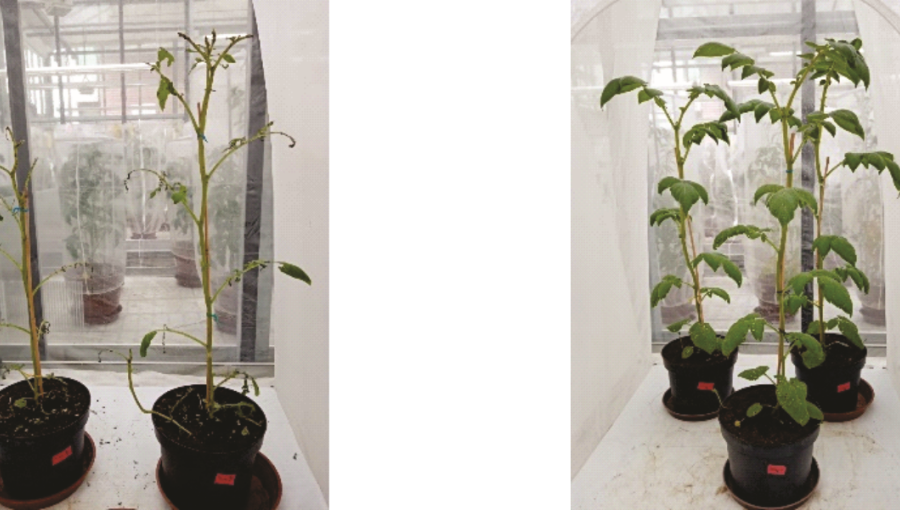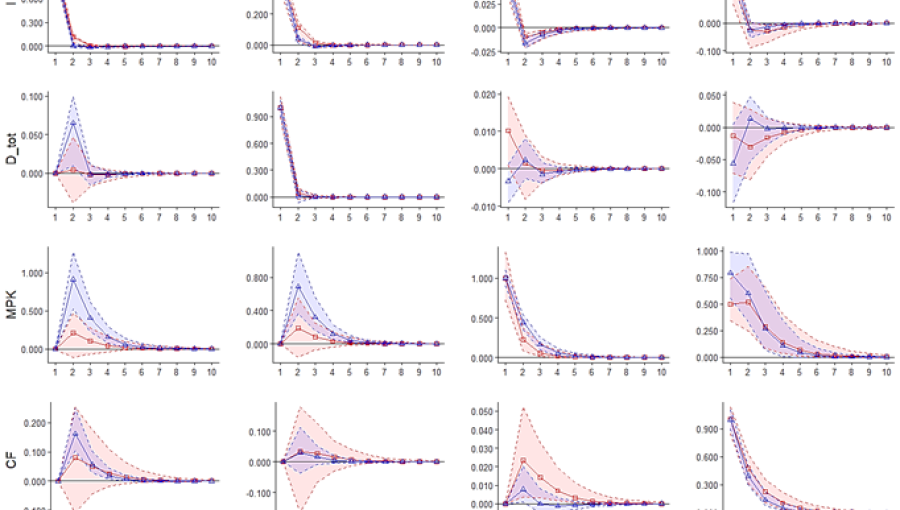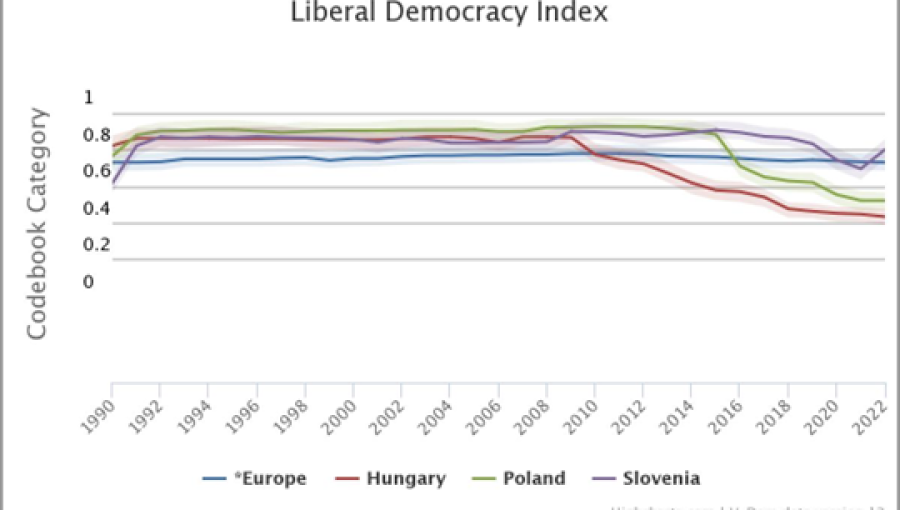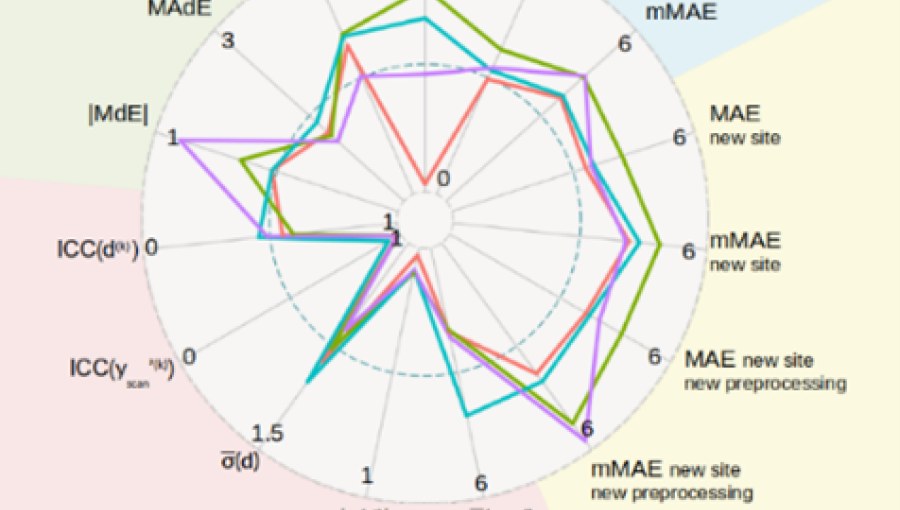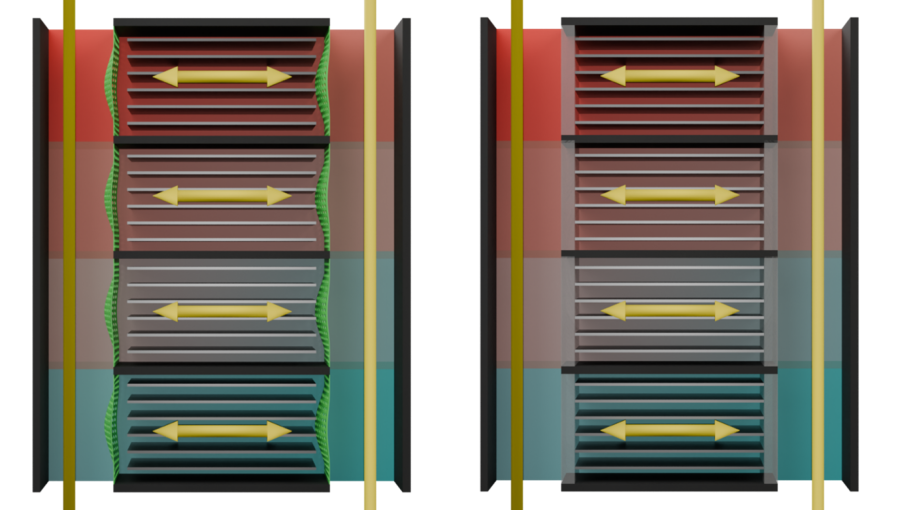Every year, the University of Ljubljana recognises 10 outstanding research achievements from the previous 12 months. In evaluating and making the final selection of the 10 most outstanding achievements, the Research and Development Committee’s working group principally takes into account their international impact, their comprehensiveness, how relevant they are to the wider professional audience and the general public, and their applicability. All the proposals were assessed equally, regardless of the discipline, and regardless of whether they involved pure or applied research.
Protein complexes from edible mushrooms as sustainable protection of potatoes against plant pests
Authors: Dr Anna Coll, Prof. Dr Kristina Gruden, Dr Maja Grundner, Asst. Prof. Dr Tjaša Lukan, Dr Anastasija Panevska, Dr Marko Petek, Karmen Pogačar, Senior Research Associate Dr Jaka Razinger, Prof. Dr Kristina Sepčić, Research Associate Primož Žigon, MSc
Proposed by: Biotechnical Faculty, University of Ljubljana
The Colorado potato beetle is one of the most wide-spread plant pests worldwide. The damage it causes is measured in billions of US dollars. It is controlled using chemical insecticides, which can accumulate in the environment and be toxic to non-target organisms and humans. An additional problem is the development of insect resistance to insecticides.
This paper describes a strategy for the development of genetically modified potato plants expressing the insecticidal protein complexes PlyA2/PlyB from the edible oyster mushroom. The transformed plants are effectively protected against Colorado potato beetle larvae, with no difference in plant morphology, growth or tuber yield compared to non-transformed plants.
PlyA2/PlyB show a number of advantages over other insecticides. Their action is linked to their binding to a membrane lipid found only in insects, and they are therefore non-toxic to non-target arthropods and mammals. They break down rapidly in the environment and are immediately degraded by mammalian digestive enzymes. Gene expression analysis of beetles surviving PlyA2/PlyB supplementation showed no signs of specific adaptation to the action of the complex.
The results of the research, whose authors are exclusively collaborators of Slovenian scientific research institutions, are protected by an international patent application and are opening the way for the development of environmentally friendly bioinsecticides, safe from resistance development, offering new possibilities for solving the problems faced by modern agriculture.
Source
Pogačar K, Grundner M, Žigon P, Coll A, Panevska A, Lukan T, Petek M, Razinger J, Gruden K, Sepčić K. Protein complexes from edible mushrooms as a sustainable potato protection against coleopteran pests. Plant Biotechnol J. 2024 Sep;22(9):2518-2529. doi: 10.1111/pbi.14365. Epub 2024 May 10. PMID: 38733093; PMCID: PMC11331795.
From crisis to prosperity: how coordinated economic policies shape our future
Author: Prof. Dr Miroslav Verbič
Proposed by: School of Economics and Business, University of Ljubljana
In today's challenging global environment, understanding the impact of financial markets and economic policies on prosperity is more important than ever. This collection of three papers, published in prestigious international journals with high impact factors, sheds light on how financial market distress, unexpected changes in crediting, and coordinated monetary and fiscal policies affect business investment and overall economic stability in Slovenia and the euro area.
The papers show how the difficulty companies face in obtaining finances in times of financial uncertainty can increase the intensity of the downturn. They reveal that banks become more cautious not only because of profit concerns, but above all because of increased financial risks, a finding that is particularly relevant in light of recent global financial pressures and the need for resilient banking practices. The papers also analyse how central bank actions and government spending and tax decisions affect economic growth and inflation. While raising interest rates can help control inflation, it can also slow economic growth. On the other hand, appropriate fiscal policies can provide the economy with immediate support, underlining the importance of well-coordinated economic policy measures.
Together, the contributions offer valuable guidance for policy makers confronted with the complexity of the global environment. They underline the need to ensure that companies have access to the financing they need and suggest tailoring policies to each country's circumstances. By combining detailed analysis at the company level with broader economic trends, they improve our understanding of contemporary economic challenges and offer practical solutions to promote stability and growth.
Sources
Zabavnik, D., Verbič, M. (2023). The Effects of Financial Frictions on Slovenian Companies: A Panel VAR Approach. Finance Research Letters, 58 (C), 104563. http://dx.doi.org/10.1016/j.frl.2023.104563
Zabavnik, D., Verbič, M. (2024). Unravelling the Credit Market Shocks and Investment Dynamics: A Theoretical and Empirical Perspective. International Review of Financial Analysis, 94, 103283. http://dx.doi.org/10.1016/j.irfa.2024.103283
Rant, V., Puc, A., Čok, M., Verbič, M. (2024). Macroeconomic Impacts of Monetary and Fiscal Policy in the Euro Area in Times of Shifting Policies: A SVAR Approach. Finance Research Letters, 64, 105406. http://dx.doi.org/10.1016/j.frl.2024.105406
Party System Changes and Challenges to Democracy: Slovenia in a Comparative Perspective
Author: Prof. Dr Danica Fink Hafner
Proposed by: Faculty of Social Sciences, University of Ljubljana
In her book, Danica Fink Hafner analyses the link between the stability of the party system and democracy. Based on a thorough theoretical framing, longitudinal research on the case of Slovenia and internationally comparative empirical research, she identifies the factors that influence the decline of democracy. Slovenia experienced a rapid but limited democratic decline in the period between March 2019 and June 2022. This is in contrast to the better-known cases of Hungary and Poland, where such a decline took place gradually over a longer period through several electoral cycles. Danica Fink Hafner has argued that there is not a single and sufficient factor that causes democratic decline; instead, it results from a complex interplay of factors (party characteristics, other players, broader social and economic factors, and in particular the various crises that allow for the introduction of states of emergency). The work thus fills an important gap in the debate on the study of political parties and processes of de-democratisation. Danica Fink Hafner's book has been published by the internationally renowned Springer Nature and is open-access. It attracted widespread interest immediately after its publication, as reflected in the number of accesses to the book on the publisher’s website.
Source
Fink Hafner, Danica. Party system changes and challenges to democracy: Slovenia in a comparative perspective. Cham: Springer Nature. DOI: 10.1007/978-3-031-54949-6
Deep models for regression of brain age as a general diagnostic criterion for neurodegenerative diseases
Authors: Asst. Lara Dular, Prof. Dr Franjo Pernuš, Assoc. Prof. Dr Žiga Špiclin (project leader)
Proposed by: Faculty of Electrical Engineering, University of Ljubljana
Prediction of brain age from magnetic resonance (MR) scans of the head and any differences between predicted and chronological age serve as a common biomarker for all diseases with a neurodegenerative effect. In this study, we developed advanced deep learning architectures to regress brain age directly from T1-weighted head MR images and, based on a large, publicly available dataset of healthy adult subjects (18–95 years), proposed a standardised protocol for evaluating regression models that includes assessing the accuracy, robustness, reproducibility and temporal consistency of brain age estimates. We demonstrated a favourable impact of advanced preprocessing of T1-weighted MR images on the reproducibility of brain age regression between different MR scanners. Age differences were comparatively evaluated for healthy control groups and affected groups with sleep apnoea, diabetes, multiple sclerosis (MS), Parkinson's disease, mild cognitive impairment and Alzheimer's dementia (AD). Patients with AD and MS showed the largest age differences (up to +6.48 and +4.24 years, respectively), but in all affected groups we observed a trend of decreasing difference with increasing age, suggesting the biased influence of survival, disease progression, therapy and lifestyle adaptation.
The study is reproducible, with publicly released data and software code, and the results have been published in three original scientific articles with an impact factor of Q1.
Sources
Dular, Lara, and Žiga Špiclin. “BASE: Brain Age Standardized Evaluation.” NeuroImage 285 (1 January 2024): 120469. https://doi.org/10.1016/j.neuroimage.2023.120469.
Dular, Lara, Franjo Pernuš, and Žiga Špiclin. “Extensive T1-Weighted MRI Preprocessing Improves Generalizability of Deep Brain Age Prediction Models.” Computers in Biology and Medicine 173 (1 May 2024): 108320. https://doi.org/10.1016/j.compbiomed.2024.108320.
Dular, Lara and Žiga Špiclin. “Analysis of Brain Age Gap across Subject Cohorts and Prediction Model Architectures.” Biomedicines 12, no. 9 (September 2024): 2139. https://doi.org/10.3390/biomedicines12092139.
Dynamics of magnetization at infinite temperature in a Heisenberg spin chain
Authors: Dr Trond I. Andersen, Prof. Dr Tomaž Prosen (lead author), Dr Eliott Rosenberg, Dr Pedram Roushan (lead author)
Proposed by: Faculty of Mathematics and Physics, University of Ljubljana
The study of quantum dynamics – how quantum systems change over time – is still a major challenge in science. One theory that addresses this is the 1D Heisenberg model, which describes how spins (small magnets) behave in a one-dimensional chain. Scientists have hypothesised that these dynamics could fit into the Kardar–Parisi–Zhang (KPZ) universality class, which describes certain types of growth and propagation in nature. In this study, the researchers used a chain of 46 superconducting qubits (the basic units of quantum computers) to study how magnetisation (a measure of the magnetic field) is transferred across the chain’s centre. They measured the probability distribution describing the likelihood that the magnetisation will reach a certain value. The first two moments of this distribution showed superdiffusive behaviour, meaning that the magnetisation spreads faster than in normal diffusion, which is a hallmark of KPZ universality. However, the third and fourth moments ruled out the KPZ conjecture and allowed for evaluating other theories. These results highlight the importance of studying higher moments (more than just the mean and variance) in determining dynamic universality classes. This provides insights into universal behaviour in quantum systems and helps in the development of new theories. More generally, this content is a fundamental yet globally extraordinary contribution to the field of quantum mechanics.
Source
Dynamics of magnetization at infinite temperature in a Heisenberg spin chain. Science. 2024, vol. 384, no. 6691, pp. 48–53, illustr. ISSN 0036-8075. Repository of the University of Ljubljana – RUL, DOI: 10.1126/science.adi7877. [COBISS.SI-ID 191659011], [Open access, JCR, SNIP, WoS until 2 October 2024: number of citations (TC): 5, pure citations (CI): 5, pure citations per author (CIAu): 0.22, Scopus until 23 September 2024: number of citations (TC): 7, pure citations (CI): 7, pure citations per author (CIAu): 0.31]
Project: P1-0402-2019 Matematična fizika; financed by: Slovenian Research and Innovation Agency.
Tunable entangled photon-pair generation in a liquid crystal
Authors: Maria V. Chekhova, Aljaž Kavčič, Emmanouil Kokkinakis, Matjaž Humar, Vitaliy Sultanov, Nerea Sebastián Ugarteche
Proposed by: Faculty of Mathematics and Physics, University of Ljubljana
Liquid crystals, with their ability to self-assemble, strong response to an electric field and integrability into complex systems, are key materials in light-beam manipulation. The recently discovered ferroelectric nematic liquid crystals also have considerable second-order optical nonlinearity, making them a potential material for nonlinear optics. This work implements spontaneous parametric down-conversion in a ferroelectric nematic liquid crystal and demonstrates electric-field tunable broadband generation of entangled photons, with an efficiency comparable to that of the best nonlinear crystals. The emission rate and polarisation state of photon pairs is markedly varied by applying a few volts or twisting the molecular orientation along the sample. A liquid-crystal source enables a special type of quasi-phase matching, which is based on the molecular twist structure and is therefore reconfigurable for the desired spectral and polarisation properties of photon pairs. Such sources promise to outperform standard nonlinear optical materials in terms of functionality, brightness and the tunability of the generated quantum state. The concepts developed in this work can be extended to complex topological structures, macroscopic devices and multi-pixel tunable quantum light sources. The content is a fundamental contribution at the interdisciplinary intersection of quantum mechanics and soft matter physics of the highest global rank.
Sources
Tunable entangled photon-pair generation in a liquid crystal. Nature: the international weekly journal of science. [Print ed.]. 2024, vol. 631, iss. 8020, pp. 294–299, illustr. ISSN 0028-0836. Repository of the University of Ljubljana – RUL, DOI: 10.1038/s41586-024-07543-5. [COBISS.SI-ID 199216387], [Open access, JCR, SNIP, WoS, Scopus until 23 September 2024: number of citations (TC): 3, pure citations (CI): 2, pure citations per author (CIAu): 0.33]
Project: 851143 Intracellular lasers: Coupling of optical resonances with biological processes [Cell-Lasers]; financed by: European Commission;
Project: P1-0099-2022 Fizika mehkih snovi, površin in nanostruktur; financed by: Slovenian Research and Innovation Agency;
Project: P1-0192-2022 Svetloba in snov; financed by: Slovenian Research and Innovation Agency.
Hypereg: a new regenerator for high-frequency solid-liquid heat regeneration
Authors: Prof. Dr Andrej Kitanovski (project leader), Asst. Prof. Dr Katja Klinar, Assoc. Prof. Dr Franc Majdič, Dr Jure Mencinger, Asst. Prof. Dr Izidor Sabotin, Dr Urban Tomc, Assoc. Prof. Dr Joško Valentinčič
Proposed by: Faculty of Mechanical Engineering, University of Ljubljana
LAHDE (Laboratory for Refrigeration and District Energy) researchers, in collaboration with other departments at the Faculty of Mechanical Engineering, have invented a new concept for a heat regenerator that allows a several-fold improvement in the power density of the devices in which it is used. Such devices include heat pumps, cooling devices and power generators based on gas or caloric thermodynamic cyclic processes. A regenerator is a heat storage and transfer device made of a solid matrix through which a working fluid oscillates.
The principles behind regenerators have been known for almost 100 years, but they have limited applications. At higher frequencies (i.e. more cycles of oscillation of the fluid flow per temporal interval), pressure losses become excessive and the time interval for heat transfer along the regenerator becomes too short.
The new regenerator concept, called Hypereg, solves the problem of excessive pressure losses and thus extends the use of regenerators to higher operating frequencies. Hypereg is hydraulically separated into several smaller compartments in which the fluid oscillates along the solid (as in a conventional regenerator), and additionally introduces an external fluid flow transverse to these compartments. The coordinated fluid flow in all parts of the Hypereg therefore allows for efficient heat regeneration between the solid and the fluid even at higher frequencies, which in turn allows for a significant increase in the power density of both caloric and gas-cycle devices, which include thermoacoustic and mechanical Stirling technologies.
The Hypereg concept, for which the inventors obtained US and Chinese patents [1], was first published in the paper [2].
Source
[1] Patent: KITANOVSKI, Andrej, TOMC, Urban, KLINAR, Katja, VALENTINČIČ, Joško, MAJDIČ, Franc, SABOTIN, Izidor, MENCINGER, Jure. Method for heat transfer in the embedded structure of a heat regenerator and the design thereof: United States patent US 12,000,663 B2, 2024-06-04. Alexandria: United States Patent and Trademark Office, 2024. [35] f., illustr. https://worldwide.espacenet.com/patent/search/family/068344965/publication/US12000663B2?q=pn%3DCN112654778A. [COBISS.SI-ID 14214659]
patent family: US201917273099A, 2019-09-02; P-2019050018, 2019-09-02; CN112654778B, 2023-08-15; EP3847361A1, 2021-07-14; SI25712A, 2020-03-31; US2021341232A1, 2021-11-04; WO2020050780A1, 2020-03-12
[2] Scientific article: Klinar, K; Kitanovski, A; Law, J Y; Franco, V; Moya, X. Perspectives and Energy Applications of Magnetocaloric, Pyromagnetic, Electrocaloric, and Pyroelectric Materials. Advanced Energy Materials, First published: 30 August 2024, Early View Online Version of Record before inclusion in an issue, 2401739, https://onlinelibrary.wiley.com/doi/10.1002/aenm.202401739
Multilingual platform FitBack to support monitoring physical fitness in children and adolescents
Authors: Asst. Prof. Dr Rok Blagus, Prof. Dr Attilio Carraro, Alessandra Colangelo, Assoc. Prof. Dr Tamas Csanyi, Dr Jose J. Gil-Cosano, Asst. Prof. Dr Mikko Huhtiniemi, Dr Laura Joensuu, Prof. Dr Gregor Jurak (project leader), Dr Katalin Kälbi, Asst. Prof. doc. dr. Bojan Leskošek, Asst. Prof. Dr João Magalhães, Asst. Prof. Dr Evelin Mäestu, Assoc. Prof. Dr Jarek Mäestu, Assoc. Prof. Dr Ivana Milanović, Asst. Prof. Dr Vladimir Milošević, Asst. Prof. Dr Shawnda A. Morrison, Prof. Dr Francisco B. Ortega, Asst. Prof. Dr Marcos Olvera Rojas, Prof. Dr Jonatan R. Ruiz, Assoc. Prof. Dr Maroje Sorić, Prof. Dr. Gregor Starc, Asst. Prof. Dr Hrvoje Podnar, Prof. Dr Luis B. Sardinha, Dr Giampaolo Santi, Prof. Dr Tuija H. Tammelin, Prof. Dr Grant R. Tomkinson
Proposed by: Faculty of Sports, University of Ljubljana
Spremljanje telesne zmogljivosti na ravni posameznika in populacije je prednostna naloga javnega zdravja in izobraževanja. Vendar je trenutno v mednarodni praksi le nekaj nacionalnih sistemov za spremljanje telesne zmogljivosti, med njimi pa je vodilna Slovenija. Pod vodstvom Fakultete za šport smo zato razvili mednarodno mrežo in večjezično spletno platformo FitBack, ki z več orodji omogoča spremljanje telesne zmogljivosti šolajočih se otrok. Na podlagi 8 milijonov zbranih podatkov o telesni zmogljivosti evropskih otrok in mladostnikov ter pregleda izsledkov raziskav o vplivu posameznih komponent telesne zmogljivosti na zdravstvene izide smo raziskovalci oblikovali evropske standarde telesne zmogljivosti. Te smo implementirali v interaktivno poročilo, ki omogoča takojšnjo povratno informacijo o telesni zmogljivosti posameznika v primerjavi z zdravstvenim tveganjem in evropskimi vrstniki. Poročilo je podprto tudi z nasveti za izboljšanje telesne zmogljivosti in pogovornim robotom.
Za odločevalce smo na podlagi analize obstoječih nacionalnih sistemov razvili priporočila za razvoj sistemov spremljanja telesne zmogljivosti otrok in mladine, opisali primere dobrih praks in pripravili evropski zemljevid telesne zmogljivosti. S tem smo vzpostavili edinstveno mednarodno mrežo in infrastrukturo, ki jo že uporabljajo v več državah.
Sources
Carraro, A., Santi, G., Colangelo, A., Mäestu, J., Milošević, V., Morrison, S. A., Olvera-Rojas, M., Podnar, H., & Jurak, G. (2023). Usability evaluation of the international FitBack web portal for monitoring youth fitness. Sport Sciences for Health, 19(4), 1363–1373. https://doi.org/10.1007/s11332-023-01117-0
Joensuu, L., Csányi, T., Huhtiniemi, M., Kälbi, K., Magalhães, J., Milanović, I., Morrison, S. A., Ortega, F. B., Sardinha, L. B., Starc, G., Tammelin, T. H., & Jurak, G. (2024). How to design and establish a national school-based physical fitness monitoring and surveillance system for children and adolescents: A 10-step approach recommended by the FitBack network. Scandinavian Journal of Medicine and Science in Sports, 34(3). https://doi.org/10.1111/sms.14593
Ortega, F. B., Leskošek, B., Blagus, R., Gil-Cosano, J. J., Mäestu, J., Tomkinson, G. R., Ruiz, J. R., Mäestu, E., Starc, G., Milanović, I., Tammelin, T. H., Sorić, M., Scheuer, C., Carraro, A., Kaj, M., Csányi, T., Sardinha, L. B., Lenoir, M., Emeljanovas, A., … Jurak, G. (2023). European fitness landscape for children and adolescents: updated reference values, fitness maps and country rankings based on nearly 8 million test results from 34 countries gathered by the FitBack network. British Journal of Sports Medicine, 57(5), 299–310. https://doi.org/10.1136/bjsports-2022-106176
What's that smell? A philosophy of the olfactory
Author: Senior Research Associate, Asst. Prof. Dr Simon Hajdini
Proposed by: Faculty of Arts, University of Ljubljana
Why is it that Indo-European languages do not have words to directly describe scents, leaving us with no choice but to simply call the smell of a rose sweet? This scholarly monograph, published by one of the most prestigious academic publishers in the world, situates itself at the intersection between philosophy, psychoanalysis and the often neglected sense of smell, in order to put smell at the centre of philosophical critique of traditional conceptions of truth through new readings of both traditional and contemporary philosophical texts, and thus to challenge the established notion of smell as an anti-philosophical sense.
With its innovative interdisciplinary approach to fundamental philosophical questions, its original analyses of modernist fiction and film, and its novel use of natural science research on olfaction in a humanistic context, the monograph places the problem of olfaction at the very heart of cultural life. In doing so, it defends the far-reaching thesis that ontology, civilisation and capitalist economy must be conceived of as waste management. And it is only by following the most philosophically debased sense that we can better understand the central philosophical, psychoanalytical and political questions of truth, sexuality and exploitation.
The work contributes to the reputation and relevance of Slovenian philosophical thought and has a significant impact on current research in the fields of sensorial studies, psychoanalysis, anthropology, political economy, aesthetics and interdisciplinary research in technology. A Spanish translation of the work is forthcoming.
Source
HAJDINI, Simon. What's that smell? : a philosophy of the olfactory. Cambridge (Mass.); London: The MIT Press, cop. 2024. XIV, 200 pages. Short circuits. ISBN 978-0-262-54756-7. [COBISS.SI-ID 183917827] category: 2A (Z, A'', A', A1/2); type of work verified by OSICH points: 160, number of authors: 1.
Membrane nanostructures
Authors: Dr Matevž Arko, Vesna Arrigler, Dr Marija Holcar, Asst. Prof. Dr Samo Hudoklin, Prof. Dr Aleš Iglič, Prof. Dr Ksenija Kogej, Prof. Dr Veronika Kralj-Iglič (project leader and lead author of the article), Prof. Dr Mateja Erdani-Kreft, Assoc. Prof. Dr Metka Lenassi, Dr Nataša Resnik, Prof. Dr Rok Romih, Anna Romolo, Dr Vesna Spasovski, Urška Zagorc
Proposed by: Faculty of Health Sciences, University of Ljubljana
The results so far show that matter and information at the cellular level are transported in the form of nano-sized particles – extracellular vesicles (EVs). Synthetic nanoparticles (liposomes and their combinations with EVs – hybridosomes) can actively interfere with this. EVs and hybridosomes can mediate interactions between all living systems and the environment, and are the cornerstone of the One Health concept. Understanding and mastering the properties of these structures and their interactions will lead to advanced solutions in medicine, agriculture, the food industry and environmental sciences. The proposed members of the Laboratory of Clinical Biophysics (LKBF) research group at the UL Faculty of Health Sciences, which brings together collaborators from several UL faculties and colleagues from abroad, have developed a method for preparing hybridosomes from lecithin, spruce needle isolate and glycerol, as reported in [1]. These hybridosomes contained bioactive substances from spruce and achieved yields that facilitate their large-scale application. Veronika Kralj-Iglič and Anna Romolo are members of the International Society for Extracellular Vesicles, which collects and disseminates information on EVs at a global level (publication [2]). In the context of their activities in the field of membrane nanostructures, they have also published a paper highlighting the importance of both experimental and theoretical work on membrane nanostructures [3]. With the proposed achievement published in ([1]–[3]), the LKBF ranks among the leading research groups in the field of biophysics of membrane nanostructures.
Sources
Spasovski Vesna, Romolo Anna, Zagorc Urška, Arrigler Vesna, Kisovec Matic, Bedina Zavec Apolonija, Arko Matevž, Molnár Adrienn, Schlosser Gitta, Iglič Aleš, Kogej Ksenija, Kralj-Iglič Veronika. Characterization of nanohybridosomes from lipids and spruce homogenate containing extracellular vesicles. International journal of nanomedicine. [Online ed.]. Feb. 2024, vol. 19, pp. 1709–1721, illustr. ISSN 1178-2013. DOI: 10.2147/IJN.S432836. [COBISS.SI-ID 186884099]. IF=8.
Welsh Joshua A, Goberdhan Deborah CI, Lenassi Metka, Witwer KW, et al., Bedina Zavec Apolonija, Holcar Marija, Hudoklin Samo, Kralj-Iglič Veronika, Erdani-Kreft Mateja, Marić Ivica, Resnik Nataša, Romih Rok, Romolo Anna, Stoka Veronika, et al. Minimal information for studies of extracellular vesicles (MISEV2023) : from basic to advanced approaches. Journal of extracellular vesicles. Feb. 2024, vol. 13, iss. 2, [article no.] e12404, pp. 1–84, illustr. ISSN 2001-3078. DOI: 10.1002/jev2.12404. [COBISS.SI-ID 185664003] IF=16, 260/244 pure citations in WoS/Scopus (2 September 2024).
Romolo Anna, Kralj-Iglič Veronika. Milestones in Research of Small Cellular Particles. Membrane Modeling and Theoretical Description in Connection with In vitro and Ex vivo processes. Proceedings of Socratic Lectures. 2024; 10: 59–68. https://doi.org/10.55295/PSL.2024.II6

